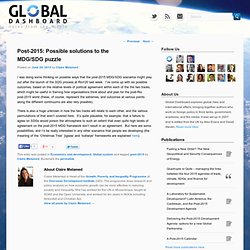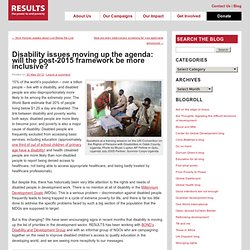

From MDGs to SDGs. Sustainable Development Goals. Outreach Mag: SDGs. Do we need SDGs? Possible solutions to the MDG/SDG puzzle. I was doing some thinking on possible ways that the post-2015 MDG/SDG scenarios might play out after the launch of the SDG process at Rio+20 last week.

I’ve come up with six possible outcomes, based on the relative levels of political agreement within each of the the two tracks, which might be useful in framing how organisations think about and plan for the post-Rio post-2015 world (these, of course, represent the extremes, and outcomes at various points along the different continuums are also very possible). There is also a huge unknown in how the two tracks will relate to each other, and the various permutations of that aren’t covered here. It’s quite plausible, for example, that a failure to agree on SDGs would poison the atmosphere to such an extent that even quite high levels of agreement on the post-2015 MDG framework don’t result in an agreement. Sustainable development goals: UN must take simple, sensible approach. The one important outcome of the Rio+20 summit was the agreement to develop a new set of goals to succeed the millennium development goals (MDGs) in 2015.

It's been a painful birth, but it would be a very big reward to secure a set of global goals that are truly universal, that integrate development and the environment, and confront the root causes of our current crises. But we need a step change in approach if we're to secure them – learning lessons from Rio+20 and other multilateral processes. At present, there is an incredible amount of confusion around this within the UN, governments and civil society. Post-Rio, we need to take a step back from the many UN processes to discuss this. The fundamentals are simple. First, this is not about the UN process. Second, we need a movement that is connected to the diverse and vibrant civil societies in Africa, Asia and Latin America, and in particular in BRICSAM countries – Brazil, Russia, India, China, South Africa and Mexico. Sustainable development is the only way forward. Brazil's environment minister Izabella Teixeira at the launch of the Vision 2050 report ahead of the Rio +20 conference on sustainable development.

Photograph: Reuters The term "sustainable development" emerged in the 1970s and 80s as awareness grew of the natural limits within which human development takes place. Despite near-universal recognition that it is a powerful unifying concept, bringing together social, economic and environmental factors, it has spent the 20 years since the first Rio Earth summit languishing in environment ministries. But it now appears possible, even probable, that sustainable development will emerge as the main framework for development practice in the coming decades, replacing or rebalancing the poverty eradication focus of recent years. Sustainable Dev. Goals (SDGs) and MDGs. A binding Food Treaty: a post-MDG proposal worth exploring (Jose Luis Vivero) Opex memorandum Nº 173/2012:________ A binding Food Treaty: a post-MDG proposal worth exploring growth in the incidence of overweight and obesity; the depletion of the main energysources on which our food production system are so heavily based, and the threatsto future food production pose by climate change. a.- Widespread Hunger, Malnutrition and Obesity: The failure of the global food system to feed the world Despite years of international anti-hunger efforts and rising per capita foodavailability, the number of hungry people has being growing since 2005. . 148million under-five children remain undernourished in developingcountries , more than 30% .

As there is no money to save their lives. And, contrary to common belief, most deaths do not happen in acute emergencies,but occur on a daily basis as a result of chronic hunger in relatively stablecountries . 300 million areobese - BMI >30. .And last but not least, micronutrient deficiency or . B. Nowadays, the global . World Bank (2012). . . . . Disability & Development. Speakers at a training session on the UN Convention on the Rights of Persons with Disabilities in Odek County, Uganda.

Photo by Bryan Lupton AP Fellow in Gulu, Uganda July 2009 Partner: Survivor Corps Uganda 15% of the world’s population – over a billion people – live with a disability, and disabled people are also disproportionately more likely to be among the extremely poor. The World Bank estimate that 20% of people living below $1.25 a day are disabled. The link between disability and poverty works both ways: disabled people are more likely to become poor, and poverty is also a major cause of disability.
But despite this, there has historically been very little attention to the rights and needs of disabled people in development work. But is this changing?